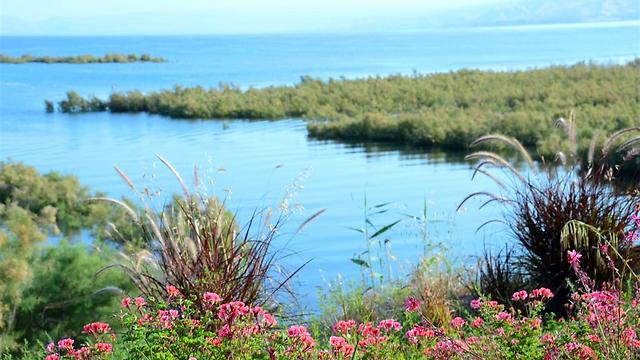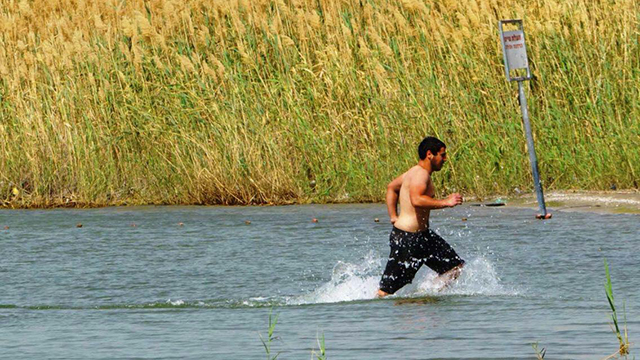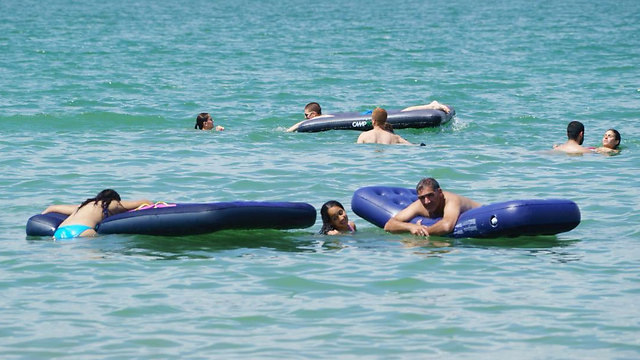
The last few dry winters northern Israel has experienced are taking their toll on the Kinneret (the Sea of Galilee), with the salt levels in the lake's water on the rise.
The drop in precipitation, which is accompanied by a reduction in water flow, has led to a situation in which less and less water has been coming into the Kinneret over the last few decades.
The average amount of available water in the Kinneret currently stands at 320 million cubic liters per year. For comparison's sake, in the 1970s that average was 480 million cubic liters per year.
In recent years, Israel has been using more and more desalinated water, which has led to less water being pumped out of the lake. But without a proper turnover of water—existing water leaving the lake while "new" water comes in—the concentration of salts in the lake's water rises.
The rise in the water's salinity may not turn the Kinneret into a salt lake anytime soon, but it carries worrying environmental effects: It leads to an increase in the growth of Cyanobacteria, microscopic algae on the surface of the lake that could damage the quality of the drinking water, and could also make the water unusable even to farmers watering crops.
The concern for the future of the Kinneret has led the Water Authority to formulate a series of measures that could stop the dangerous trend. These measures will be presented at the Annual Conference for Science and Environment next week.
The Kinneret's water may be sweet drinking water, but it also has natural salinity, the result of salt water springs flowing around the lake, and salt water bubbling under it. The salinity of the water is measured based on the level of chloride, which is created when certain types of salts dissolve in the water.
The salinity of the water in the Kinneret is about 300 chloride milligrams per liter. The highest level of salinity was measured in the 1960s when it stood at 400 chloride milligrams per liter. The lake's natural salinity in those years was too high and was unable to meet the water supply needs, especially in agriculture. As a result, Israel constructed a salt-water carrier in 1964 that would drain the water coming from the salt water springs and carry them to the Jordan River in the south of the Kinneret. Its construction led to a drop in the salinity of the lake to around 200 chloride milligrams per liter.
In recent years, alongside a drop in the amount of water coming into the Kinneret, there has been a renewed trend of increasing salinity.
"Today, the level of chloride in the Kinneret is 280 chloride milligrams per liter, and we already know that in the fall we'll be nearing 300 chloride milligrams per liter," said Dr. Doron Merkel, head of the Water Authority's Kinneret department.
The standard for chloride in Israel's drinking water was updated in 2013, dropping from 600 to 400 chloride milligrams per liter. But it remains high compared to the US, where the standard is only 250 chloride milligrams per liter. And while the effect it has on the quality of drinking water is mostly in its taste, the main reason to limiting the salinity of the water is so it can be used to water crops with sensitivity to salinity.
High levels of chloride could pose a significant danger to many crops, among them citrus trees and avocado. High salinity could reduce the rate of growth for many crops. The problem becomes even more acute when farmers use treated wastewater to water their crops.
"In the process of treating wastewater, their level of salinity rises further," Dr. Merkel explained.
If the problem is not addressed at the origin of the water, the Kinneret, the levels of chloride in treated wastewater used to water crops could reach 400 chloride milligrams per liter, which could seriously endanger the crops.
What's the solution?
According to different assessments, the reduced rainfall in the Kinneret area is not a problem that is expected to improve in the foreseeable future, and could even worsen in the coming years.
The solution lies in adding new water sources to the Kinneret, partly by building a water desalination facility in the Western Galilee.
"Farmers from the Western Galilee currently get water that originates in the Upper Galilee," Dr. Merkel explained. "If they receive desalinated water instead, the water they are currently using could be used to enriching the Kinneret's water."
In addition, sweet water can be added to the Kinneret through drilling. Furthermore, the Water Authority is planning to reduce the concentration of salt water from the Kinneret using the salt-water carrier, and the Kinneret Authority is planning to impose some limitations on water consumption for agriculture.
"The farmers are having a hard time about it, but we have no choice," said Dr. Merkel.
There are steps that can be taken to deal with the growing of the algae as well: Reducing the amounts of phosphorus and increasing the amount of nitrogen that enters the Kinneret's water. The two processes occurred naturally in the past in the Hula Valley, when the water went through a natural filtration in the swamp before reaching the Kinneret. It is possible some of these processes can be recreated by "reviving" the Hula Valley's traditional role in the Jordan River estuary.
Despite the fact desalinated water already provide half of the water coming out of taps in Israel, the vulnerability of desalination facilities and the serious ramifications of one of them going offline emphasize the importance of the Kinneret as a strategic water source, Dr. Merkel said.
"The master plan for the water supply (2050) determines that the Kinneret will remain a strategic water source in the next 40 years," Dr. Merkel noted.



















